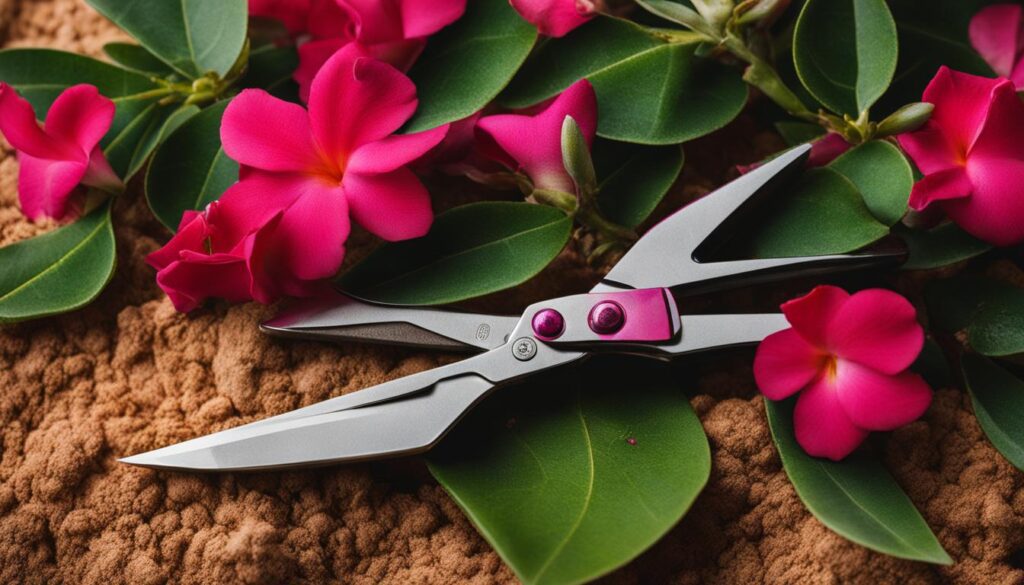Pruning a desert rose, also known as adenium or mock azalea, is essential for maintaining a healthy and bushy plant. By pruning your desert rose, you can prevent it from becoming long and leggy while encouraging more flowers to bloom. In this section, we will provide you with tips and techniques for effectively pruning your desert rose.
Before we dive into the specifics of pruning, let’s understand why it is crucial for the adenium obesum. Pruning before blooming is ideal because the desert rose blooms on new growth. However, it’s important to avoid late autumn pruning to prevent frost damage to the tender new growth.
When you’re ready to prune, make sure to sterilize your cutting blades with rubbing alcohol or a 10 percent bleach solution. This simple step will help prevent the spread of diseases among your plants.
Start by removing any cold-damaged growth and cutting back long, lanky shoots to the same length as other stems. Additionally, prune branches that rub or cross each other to maintain a clean and organized plant structure. Make clean cuts at a 45-degree angle just above a leaf node to allow for new growth to emerge.
Lastly, keep an eye out for signs of powdery mildew and remove any affected leaves and stems promptly. By following these tips, you can ensure your desert rose remains healthy, bushy, and vibrant.
Tools and Techniques for Desert Rose Pruning
To effectively prune your desert rose, you will need a few tools: sharp pruning shears with bypass blades, loppers for larger branches, and occasionally a pruning saw for very thick cuts. It’s important to use clean and sharp tools to minimize the risk of spreading disease.
Before pruning, sterilize your cutting blades by either dipping them in rubbing alcohol or wiping them with a 10 percent bleach solution. This step is crucial to ensure the health of your plant and prevent any potential infections.
When making cuts, always cut above a growth node, which is a small lump on the stem where a leaf used to be. By cutting above a growth node, you encourage new growth to emerge from that point, resulting in a more bushy and vibrant plant.
Remember to cut at an angle of 45 degrees when pruning your desert rose. This angle creates a natural appearance and helps prevent water from collecting on the cut surface and potentially causing rot.
It is important to avoid pruning your desert rose in late autumn to prevent frost damage to new, tender growth. Wait until after the risk of frost has passed and the plant has entered its active growth phase before pruning.
Incorporating these tools and techniques into your desert rose pruning routine will promote healthy growth, encourage blooming, and ensure the longevity of your plant.
Pruning Tools for Desert Rose
When pruning your desert rose, having the right tools is essential for achieving clean and precise cuts. Here are the key tools you’ll need:
- Pruning shears with bypass blades: These handheld shears are ideal for cutting through small to medium-sized branches.
- Loppers: Use loppers to tackle larger branches that are too thick for pruning shears. They provide more leverage and cutting power.
- Pruning saw: For exceptionally thick branches, a pruning saw is necessary. This tool allows you to make clean cuts without damaging the branch or stem.
Investing in high-quality tools will make the pruning process easier and help you achieve the best results for your desert rose.
Tips for Pruning Different Types of Desert Roses
When it comes to pruning your desert rose, it’s important to understand the specific methods required for the different types of roses. Let’s take a closer look at how to prune hybrid teas, floribundas, minifloras, climbing roses, and old garden roses.
Pruning Hybrid Teas
To prune hybrid teas, start by removing any broken or damaged growth. Next, cut back the branches to leave 6 to 8 growth nodes. When making the cut, aim for an outside growth node about 1/2 to 3/4 inch above the node, facing outward from the center of the plant. This will help promote outward growth and bushiness.
Pruning Floribundas
Floribundas can be pruned in a similar way to hybrid teas. However, since they tend to have more and smaller limbs coming from the base, take care to remove any crossed or rubbing branches. Make clean cuts just above a growth node to encourage healthy growth.
Pruning Minifloras
Minifloras and miniatures can be pruned following the same principles as hybrid teas, but on a smaller scale. Remove any dead or damaged growth and cut back to 4 to 6 growth nodes. By doing so, you’ll encourage these smaller roses to develop full, compact forms.
Pruning Climbing Roses
When it comes to pruning climbing roses, the focus is on promoting horizontal growth, which will lead to more blooms. Remove any dead or damaged wood, as well as any weak or thin stems. Train the main canes horizontally along a support structure, as this will stimulate the growth of lateral shoots that will bear more flowers.
Pruning Old Garden Roses
Old garden roses, with their single bloom time and lack of repeat blooming, require a different approach to pruning. Remove any dead or diseased wood, as well as any crossed or rubbing branches. Keep in mind that old garden roses often have an elegant and natural shape, so avoid excessive pruning that may disrupt their natural form.
Is the Pruning Process Similar for Desert Rose and Dahlias?
The pruning process for desert rose and dahlias is not similar. While pruning dahlias for vibrant blooms requires cutting back dead stems and spent flowers, desert rose pruning involves removing dead or unhealthy branches and shaping the plant. Both plants require different pruning techniques to thrive and bloom.










